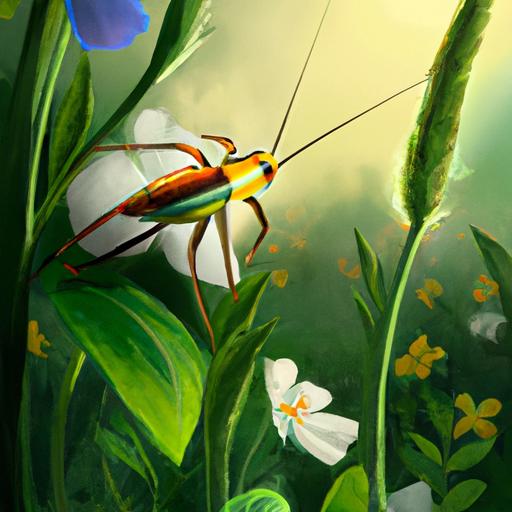Have you ever wondered why crickets bite? Ever felt a pinch and thought it was one of these small, hopping insects? Crickets are among us and understanding their behavior is the key to preventing and treating any bites they may inflict.
In this article, we will explore the different types of crickets, why they bite, how to identify them, and what to do if you are bitten by one.
Read on to learn the facts about what type of crickets bite and how to protect yourself from their tiny jaws.
Table of Contents
Short Answer
Crickets typically do not bite humans, as they are not equipped with a mouth part designed for biting.
However, some species of crickets, such as the camel cricket, can bite humans if they feel threatened.
The bite is generally not serious and will not cause any lasting damage.
In addition, some species of crickets are capable of piercing human skin with their long legs.
These bites are generally not harmful, but can be painful and cause swelling.
Types of Crickets
When it comes to understanding crickets and what type of crickets bite, it is important to know the different types of crickets that exist.
The three most common types of crickets are the House Cricket, Field Cricket, and Mole Cricket.
The House Cricket is the most common type of cricket found in homes.
These crickets are usually brown or black in color, and can grow up to an inch in length.
They are nocturnal and omnivorous, meaning they feed on both plants and insects.
Though they do not usually bite humans, it is possible for them to do so if they feel threatened.
The Field Cricket is a species that is usually found in outdoor fields.
They can range in color from black to brown and are typically a little larger than House Crickets.
They are also omnivorous, and while their bites are not usually harmful, they may bite if they feel threatened.
The Mole Cricket is a species of cricket that is usually found in moist, warm environments.
They are often brown or black in color and can grow up to two inches in length.
These crickets are also omnivorous and, while they rarely bite humans, their bites can be painful if they do occur.
All three of these types of crickets can be found in different parts of the world, and it is important to be aware of the different types of crickets that exist in order to understand which ones may bite.
While it is rare for these crickets to bite, it is still important to know the facts in order to be prepared.
Why Crickets Bite

Crickets are generally harmless creatures, but there are some species that are known to bite namely the House Cricket, Field Cricket, and Mole Cricket.
These types of crickets are typically found in areas with warm, moist environments, and they may bite if they feel threatened.
Its important to understand why crickets bite in order to better protect yourself from potential bites.
Crickets are naturally defensive creatures, and they may bite if they feel threatened by a sudden movement or loud noise.
They may also bite if they are trying to protect their eggs or if they feel the need to establish territory.
Crickets may also be attracted to certain smells, such as sweat or perfumes, which can cause them to bite if they mistake the smell for food.
Additionally, crickets may bite if they are startled or if they feel the need to escape from a predator.
In some cases, crickets may bite in self-defense, as they may not recognize humans as predators.
Its important to note that, while crickets can bite, their bites are generally not harmful to humans.
The bites may be uncomfortable, but they are not known to spread any diseases or cause any lasting damage.
Identifying Crickets That Bite
When it comes to identifying crickets that bite, there are a few key traits to look out for.
First, the most common type of cricket that bites is the house cricket.
These insects are typically light brown in color and have long antennae.
They have long, slender legs and can reach up to 1.5 inches in length.
Additionally, they tend to prefer warm, moist environments, such as basements or crawl spaces.
Another type of cricket that bites is the field cricket.
These are larger than the house cricket, growing up to 2 inches in length, and they are typically dark brown in color.
They tend to prefer areas with grass or weeds, such as pastures or hayfields.
Finally, the mole cricket is another type of cricket that bites.
These insects are black or brown in color and have a flattened head.
They can reach up to 3 inches in length and are known to burrow in the ground.
They prefer damp soil, such as near a pond or river.
Regardless of the type of cricket, it is important to note that these insects will generally only bite if they feel threatened.
Their bites are usually not harmful to humans, so it is important to be aware of their presence and take steps to keep them away from your home.
Signs of a Cricket Bite

Cricket bites can be difficult to identify, as they may not appear to be painful or cause any noticeable marks.
However, there are some signs that indicate a cricket may have bitten you.
These include redness and swelling near the bite site, as well as a stinging or burning sensation.
You may also experience itching or tenderness around the area.
In some cases, a cricket bite may cause a small blister or a small lump that can last for several days.
If you experience any of these signs, it is important to seek medical attention.
Additionally, it is important to inspect the area around the bite for any remaining cricket parts, as this may help to identify the type of cricket that bit you.
Treating a Cricket Bite
Cricket bites are usually harmless, but its still important to take the necessary precautions to avoid them.
If youve been bitten by a cricket, the first thing you should do is to clean the area with warm, soapy water.
This will help to reduce any potential irritation or infection.
You can also apply a cold compress to the bite to reduce inflammation and swelling.
In some cases, a topical ointment or cream may be recommended to help reduce itching and discomfort.
If youre experiencing severe pain, you may need to take an over-the-counter pain reliever such as ibuprofen.
If symptoms persist or worsen, its important to seek medical attention.
Its also important to take precautions to avoid being bitten by crickets.
To do this, you should remove any potential sources of food or shelter that can attract crickets.
This includes keeping your home clean and dry and making sure there are no cracks or crevices in your walls or floors.
You should also make sure to wear long sleeves and pants when working in areas where crickets are likely to be present.
By understanding the facts about what type of crickets bite, you can take the necessary steps to protect yourself and your family from these pests.
Remember to always clean the area if youve been bitten and seek medical attention if the symptoms are severe or worsening.
If you take the right precautions, you can help to prevent cricket bites and enjoy a pest-free home.
Preventing Cricket Bites

If youre concerned about being bitten by crickets, there are some steps you can take to prevent such an occurrence.
First and foremost, its important to be aware of the type of environment crickets prefer.
These insects thrive in warm, moist areas, so keeping these conditions away from your home is key.
This means keeping your home dry and ventilated, and avoiding areas with high humidity.
Additionally, its important to keep your home clean.
Crickets are attracted to food and trash, so be sure to keep your home free of crumbs and other food debris that might attract these insects.
If you do find yourself in a situation where you are dealing with crickets, make sure to handle them carefully.
Crickets are generally harmless, but they can feel threatened if they are handled roughly.
If you must pick one up, use a soft cloth or glove to avoid being bitten.
Additionally, its important to avoid using any type of insecticide or pesticide on crickets.
These chemicals can be harmful to humans and can potentially cause serious injury if used incorrectly.
If you find yourself in a situation where you must use an insecticide, make sure to follow all directions and safety precautions.
Finally, its important to be aware of the signs of a cricket bite and to seek medical attention if necessary.
Generally, a cricket bite will not be very painful and may leave a small red mark on the skin.
If the bite becomes infected or if you experience any symptoms such as fever, nausea, or vomiting, its important to seek medical attention.
By understanding the facts about cricket bites and taking the necessary precautions, you can help ensure that you and your family stay safe from these insects.
What to Do if You are Bitten by a Cricket
If you are bitten by a cricket, the best thing to do is to wash the area with soap and water, and apply an antiseptic such as hydrogen peroxide or rubbing alcohol to the bite site.
This will help to prevent any potential infection.
If the bite does become infected, seek medical attention for proper treatment.
In addition, it is important to identify the type of cricket that bit you, if possible.
This will help you to determine whether the cricket is capable of causing any serious harm.
House crickets, field crickets, and mole crickets are the most common types of crickets that are known to bite humans, and they are generally considered to be harmless.
However, if you are bitten by any other type of cricket, it is best to seek medical attention just to be safe.
If you suspect that a cricket has bitten you, it is important to take the necessary precautions to avoid any further bites.
Wear long sleeves and pants when going outside, and consider using an insect repellent containing DEET.
Additionally, make sure to keep your home clean and free of clutter, as this can provide a hospitable environment for crickets to thrive.
Finally, if you notice any crickets in your home, it is best to contact a pest control professional for assistance in getting rid of them.
Final Thoughts
Crickets can be found in many places around the world, and while most of them do not bite, there are some that can.
The House Cricket, Field Cricket, and Mole Cricket are the species that are known to bite.
If you think you may have been bitten by one of these crickets, look for signs such as redness and swelling, and seek medical attention if necessary.
To prevent cricket bites, keep your home and yard clean and free of debris, and avoid handling or disturbing the crickets.
With this knowledge, you can be prepared to handle any cricket bite situation that may arise.

